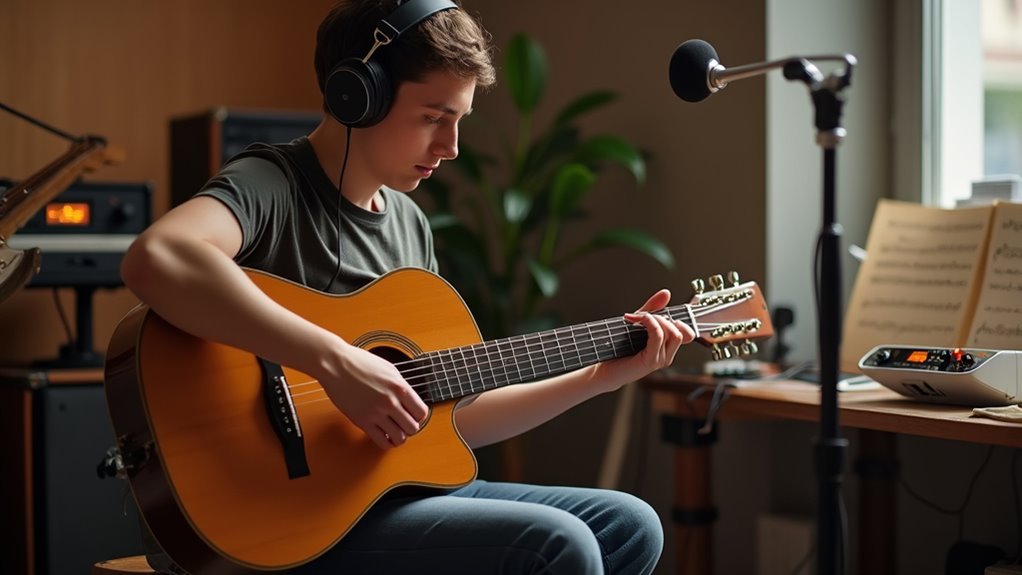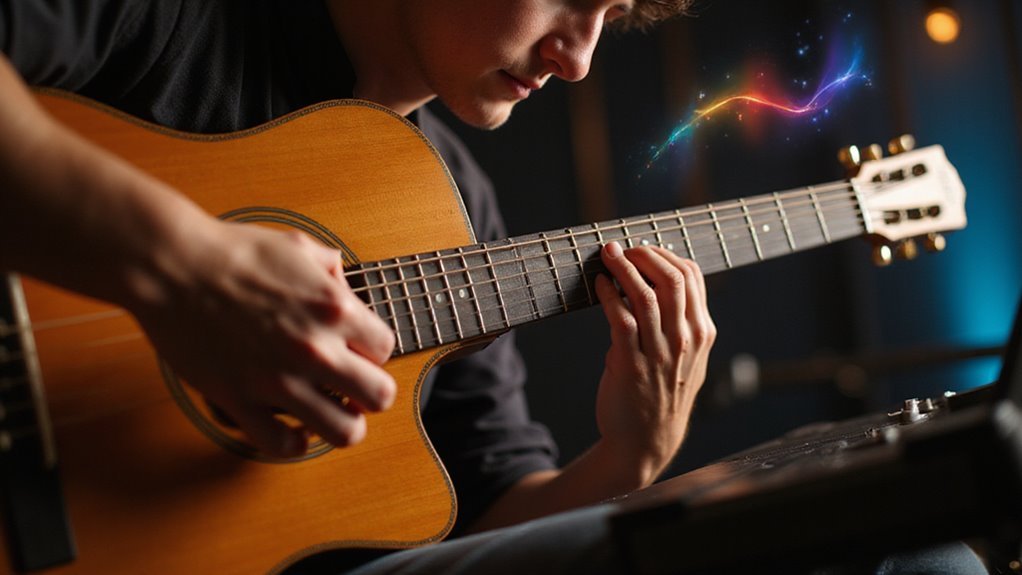Your ear might be holding back your guitar playing more than your fingers. Even technically skilled guitarists often struggle to identify intervals, chords, and progressions by ear—skills that separate good players from great musicians. I’ve noticed this in my own journey too; you can practice scales for hours, but without training your ear, you’ll miss the musical conversations happening around you. Perhaps developing this hidden skill could transform not just how you learn songs, but how you connect with music entirely.
The Foundation: Mastering Pitch and Interval Recognition

The human ear is a remarkable instrument—perhaps the most valuable tool any guitarist can develop.
When you’re starting your journey toward better musical hearing, pitch and interval recognition form your foundation.
Begin with simple pitch exercises—try matching single notes you hear with your guitar. It’s challenging at first, I think, but stick with it. Your progress might feel slow, but trust me, your brain is adapting.
Intervals—the spaces between notes—are equally important. Start with obvious ones like octaves, then gradually work toward recognizing more subtle differences.
Chord Progressions: Training Your Ear to Identify Harmonic Structures

When you’ve mastered individual notes and intervals, moving into chord progressions becomes your next exciting challenge. This is where music truly comes alive – those magical sequences that form the backbone of your favorite songs.
Start with simple progressions like I-IV-V in major keys. Perhaps play along with recordings, pausing occasionally to guess what comes next. I think many guitarists find this frustrating at first, but stick with it!
Try backing tracks too – they’re perfect for training your ear without distraction. Some days you’ll nail it, others not so much. That’s totally normal.
Your musical community will appreciate when you can quickly pick up progressions during jam sessions.
Scale Identification: Hearing the Building Blocks of Music

Scales form the foundation of all music you’ll ever play, hear, or create on your guitar. When you train your ear to recognize these patterns, you’re fundamentally learning the DNA of music itself. I think many guitarists overlook this skill, focusing instead on technique alone.
| Scale Type | Emotional Quality | Common In |
|---|---|---|
| Major | Bright, Happy | Pop, Rock |
| Minor | Melancholic, Tense | Blues, Metal |
| Pentatonic | Versatile, Smooth | Almost Everything |
Practice by playing along with your favorite songs, perhaps trying to identify which scale they’re using. This might feel challenging at first, but your musical intuition will develop naturally with time.
The Singing Guitarist: Connecting Voice and Instrument
Connecting your voice with your guitar creates a powerful musical synergy that few other skills can match. When you sing while playing, you’re training your ear in perhaps the most natural way possible. I think it’s because your voice becomes an extension of what your fingers are doing on the fretboard.
Start simple—maybe with a basic three-chord song you already know. Don’t worry about sounding perfect at first; that awkward coordination phase happens to everyone.
Your confidence will grow as you practice, and you’ll notice you’re relying less on tabs and more on what feels right musically.
Rhythm Recognition: Developing Your Inner Metronome
Rhythm, the heartbeat of all music, often separates casual players from those who can truly captivate an audience. When you develop your inner metronome, you’re not just counting beats—you’re feeling the pulse that drives every song you’ll ever play.
Your internal rhythm isn’t just a skill—it’s the invisible force that transforms notes into music that moves people.
I think this might be the most overlooked skill for guitarists focused on learning scales and chords.
Practice these four rhythm recognition exercises:
- Clap along to songs with complex time signatures
- Record yourself playing against a metronome, then listen back
- Tap different body parts to represent different instruments in a song
- Try playing familiar riffs with altered rhythms
Transcription Techniques: Learning Songs by Ear
The art of transcribing music by ear represents perhaps the most transformative skill you’ll ever develop as a guitarist. It’s the moment when all those ear training exercises truly come together in real-world application.
Start with simple songs you already know well. Listen to short segments—maybe just four beats at first—then pause and try to play what you heard. Don’t worry about getting it perfect immediately; this process is supposed to be challenging.
I find that slowing down recordings helps tremendously when you’re beginning. Most streaming services or YouTube allow this now, and it’s honestly a game-changer for catching those tricky passages.
Tech-Assisted Ear Training: Apps and Tools for Modern Musicians
While traditional methods of training your ear remain invaluable, today’s musicians have an unprecedented advantage with technology at their fingertips. I think we’re living in the golden age of learning, where apps can transform mundane ear training into something actually enjoyable.
Modern tools offer features our musical ancestors could only dream about:
- Instant feedback on pitch and rhythm recognition
- Gamified learning that triggers dopamine while you improve
- Customizable difficulty levels that grow with your skills
- Community features connecting you with fellow ear-training enthusiasts
Perhaps the greatest benefit is accessibility—you can practice anywhere.
Your musical journey doesn’t need to be isolated anymore; technology brings us together as we develop our ears.
Frequently Asked Questions
How Long Does It Take to Develop a Good Musical Ear?
You’ll develop a good musical ear in 6-12 months with consistent practice. It’s not about talent—it’s about your dedication to daily ear training exercises and active listening.
Can Ear Training Overcome Tone Deafness?
While you might feel vocally challenged, ear training can greatly improve pitch perception for most people. You’re not truly tone deaf unless you’ve been clinically diagnosed with amusia, which is rare.
Should I Learn Theory Before Starting Ear Training?
You don’t need to learn theory first. Both can complement each other beautifully. Start ear training now—you’ll actually grasp theory concepts more intuitively as your ear develops.
Does Playing by Ear Diminish Sheet Music Reading Skills?
Playing by ear doesn’t diminish your reading skills. You can develop both abilities simultaneously—they’re complementary methods for experiencing music. Many well-rounded musicians maintain expertise in both skill sets.
Can Adults Develop Ear Training Skills as Effectively as Children?
Like an old dog mastering new tricks, you can absolutely develop ear training skills as an adult. While children may learn faster, your maturity and focused practice will yield impressive results over time.
Conclusion
You’ll transform your musical instincts with these ear training techniques—perhaps faster than you ever thought possible! Listen closely, and you’ll start hearing music in ways that’ll blow your mind. Some days might feel frustrating, but stick with it. Your fingers will eventually find notes before your brain even processes them. I think that’s when you’ll know you’ve truly revealed your guitarist’s ear—when music becomes as natural as breathing.